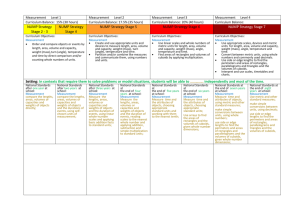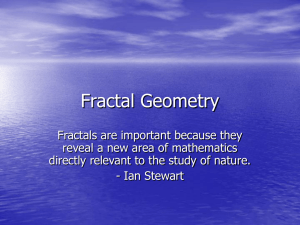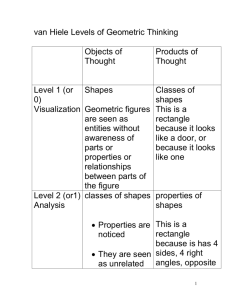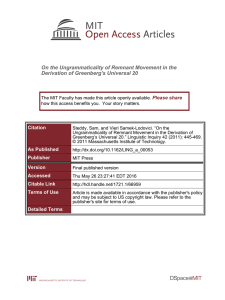Geometry & Measurement - Masterton Primary School
advertisement
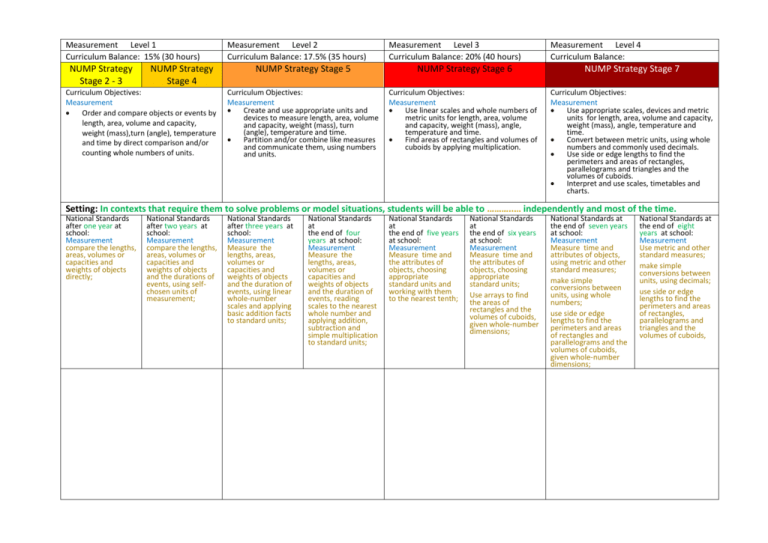
Measurement Level 1 Curriculum Balance: 15% (30 hours) NUMP Strategy Stage 2 - 3 NUMP Strategy Stage 4 Curriculum Objectives: Measurement Order and compare objects or events by length, area, volume and capacity, weight (mass),turn (angle), temperature and time by direct comparison and/or counting whole numbers of units. Measurement Level 2 Curriculum Balance: 17.5% (35 hours) Measurement Level 3 Curriculum Balance: 20% (40 hours) Measurement Level 4 Curriculum Balance: NUMP Strategy Stage 5 NUMP Strategy Stage 6 NUMP Strategy Stage 7 Curriculum Objectives: Measurement Create and use appropriate units and devices to measure length, area, volume and capacity, weight (mass), turn (angle), temperature and time. Partition and/or combine like measures and communicate them, using numbers and units. Curriculum Objectives: Measurement Use linear scales and whole numbers of metric units for length, area, volume and capacity, weight (mass), angle, temperature and time. Find areas of rectangles and volumes of cuboids by applying multiplication. Curriculum Objectives: Measurement Use appropriate scales, devices and metric units for length, area, volume and capacity, weight (mass), angle, temperature and time. Convert between metric units, using whole numbers and commonly used decimals. Use side or edge lengths to find the perimeters and areas of rectangles, parallelograms and triangles and the volumes of cuboids. Interpret and use scales, timetables and charts. Setting: In contexts that require them to solve problems or model situations, students will be able to ………..… independently and most of the time. National Standards after one year at school: Measurement compare the lengths, areas, volumes or capacities and weights of objects directly; National Standards after two years at school: Measurement compare the lengths, areas, volumes or capacities and weights of objects and the durations of events, using selfchosen units of measurement; National Standards after three years at school: Measurement Measure the lengths, areas, volumes or capacities and weights of objects and the duration of events, using linear whole-number scales and applying basic addition facts to standard units; National Standards at the end of four years at school: Measurement Measure the lengths, areas, volumes or capacities and weights of objects and the duration of events, reading scales to the nearest whole number and applying addition, subtraction and simple multiplication to standard units; National Standards at the end of five years at school: Measurement Measure time and the attributes of objects, choosing appropriate standard units and working with them to the nearest tenth; National Standards at the end of six years at school: Measurement Measure time and the attributes of objects, choosing appropriate standard units; Use arrays to find the areas of rectangles and the volumes of cuboids, given whole-number dimensions; National Standards at the end of seven years at school: Measurement Measure time and attributes of objects, using metric and other standard measures; make simple conversions between units, using whole numbers; use side or edge lengths to find the perimeters and areas of rectangles and parallelograms and the volumes of cuboids, given whole-number dimensions; National Standards at the end of eight years at school: Measurement Use metric and other standard measures; make simple conversions between units, using decimals; use side or edge lengths to find the perimeters and areas of rectangles, parallelograms and triangles and the volumes of cuboids, In class you will see and hear; Length and Area Use of non-standard units Use of appropriate language (eg longer than, wider, taller) Comparisons of lengths using m mm cm km Estimations of length & area Ordering different lengths & areas using self-chosen units Use of equipment In class you will see and hear; Length and Area Non-standard units Standard units being developed Benchmarks – estimation and approximation of suitable measurements Standard units mm m cm km Practical use of metric units Estimation to nearest unit Area via early additive strategies & some simple multiplication In class you will see and hear; Length and Area Measurement units Practical activities Conversion between units Integration of numeracy knowledge Problem-solving / rich tasks Written working formulae Relevant equipment Displays Relevant contexts In class you will see and hear; Length and Area Rich Tasks Independent investigations Hands on Learning Problem Solving with justification Finding shortest routes Use of mm cm and m Miles / kilometres Approximation Estimation Weight and Capacity Use of scales, bottles, measuring cups Comparing weights & capacity using appropriate language (eg heaviest, heavier, full, empty) Use of cooking as an authentic context Comparing weights & volumes Estimating weights & volumes Ordering weights & volumes Using kg g T l ml Weight and Capacity Use of standard units ml l g kg Cooking / science Measuring Comparing weights / volumes Use of non-standard measurements Measuring to nearest l ml Using the best measurements Weight and Capacity As above for length & area Deliberate teaching of capacity Mathematical language kg, g, tonne Use of FIO, ARBs etc Weight and Capacity Density gravity volume Linking into different curriculum areas in real life contexts – science, social science, food technology Time and Temperature Use of appropriate language – hotter colder Use of temperature / weather chart Using thermometers to measure temperature and different liquids Sequencing time Reading timetables Knowing time to ½ hour intervals Using months of the year and days of the week correctly Time and Temperature Time telling at 5 minute intervals Analogue / digital time Transferring am / pm Using time & distance approximations Real life context use of temperature Recognition of length of minutes and seconds Duration of time – real life context Time and Temperature Analogue / digital / 24 hour conversion Variety of problem solving / rich tasks Use of relevant contexts eg timetables Time and Temperature Estimation of time Degree conversion Celsius / Fahrenheit 12 / 24 hour clocks Ambient temperature / wind chill / wind direction Geometry Level 1 Curriculum Balance: 15% (30 hours) NUMP Strategy Stage 2 – 3 NUMP Strategy Stage 4 Curriculum Objectives: Shape Sort objects by their appearance. Position and Orientation Give and follow instructions for movement that involves distances, directions, and half or quarter turns. Describe their position relative to a person or object. Transformation Communicate and record the results of translations, reflections, and rotations on plane shapes Geometry Level 2 Curriculum Balance: 17.5% (35 hours) Geometry Level 3 Curriculum Balance: 20% (40 hours) Geometry Level 4 Curriculum Balance: NUMP Strategy Stage 5 NUMP Strategy Stage 6 NUMP Strategy Stage 7 Curriculum Objectives: Shape Sort objects by their spatial features, with justification. Identify and describe the plane shapes found in objects. Position and Orientation Create and use simple maps to show position and direction. Describe different views and pathways from locations on a map. Transformation Predict and communicate the results of translations, reflections, and rotations on plane shapes Curriculum Objectives: Shape Classify plane shapes and prisms by their spatial features. Represent objects with drawings and models. Position and Orientation Use a co-ordinate system or the language of direction and distance to specify locations and describe paths. Transformation Describe the transformations (reflection, translation or enlargement) that have mapped one object onto another. Curriculum Objectives: Shape Identify classes of two- and threedimensional shapes by their geometric properties. Relate three-dimensional models to twodimensional representations and vice versa. Position and Orientation Communicate and interpret locations and directions, using compass directions, distances and grid references. Transformation Use the invariant properties of figures and objects, under transformations (reflection, rotation, translation or enlargement). Setting: In contexts that require them to solve problems or model situations, students will be able to ………..… independently and most of the time. National Standards after one year at school: Geometry sort objects and shapes by a single feature and describe the feature, using everyday language; represent reflections and translations by creating patterns; describe personal locations and give directions, using everyday language. National Standards after two years at school: Geometry sort objects and shapes by different features using mathematical language; represent reflections and translations by creating and describing patterns; describe personal locations and give directions, using steps and half- or quarter- turns. National Standards after three years at school: Geometry sort objects and twoand threedimensional shapes by their features, identifying categories within categories; represent reflections, translations and rotations by creating and describing patterns; describe personal locations and give directions, using whole-number measures and halfor quarter- turns. National Standards at the end of four years at school: Geometry sort objects and twoand threedimensional shapes by two features simultaneously;; represent and describe the symmetries of a shape; create nets for cubes; describe personal locations and give directions, using simple maps. National Standards at the end of five years at school: Geometry sort two- and threedimensional shapes, considering the presence and/or absence of features simultaneously and justifying the decisions made; represent and describe the results of reflection, rotation and translation on shapes; create nets for rectangular prisms; draw plan, front and side views of objects; describe locations and give directions, using grid references and points of the compass. National Standards at the end of six years at school: Geometry sort two- and threedimensional shapes (including prisms), considering given properties simultaneously and justifying the decisions made; represent and describe the results of reflection, rotation and translation on shape or patterns; identify nets for rectangular prisms; draw or make objects, given their plan, front and side views; describe locations and give directions, using grid references, turns and points of the compass. National Standards at the end of seven years at school: Geometry sort two- and threedimensional shapes into classes, defining properties and justifying the decisions made; identify and describe the transformations that have produced given shapes or patterns; create or identify nets for rectangular prisms and other simple solids; draw plan, front, side and perspective views of objects;; describe locations and give directions, using grid references, simple scales, turns and points of the compass. National Standards at the end of eight years at school: Geometry sort two- and threedimensional shapes into classes, considering the relationships between the classes and justifying the decisions made; identify and describe the features of shapes or patterns that change or do not change under transformation; create or identify nets for rectangular prisms and other simple solids given particular requirements; draw or make objects, given their plan, front and side views or their perspective views; describe locations and give directions, using scales, bearings and co-ordinates. Level 1 Curriculum Balance: 15% (30 hours) NUMP Strategy Stage 2 – 3 NUMP Strategy Stage 4 Level 2 Curriculum Balance: 17.5% (35 hours) NUMP Strategy Stage 5 Level 3 Curriculum Balance: 20% (40 hours) NUMP Strategy Stage 6 Level 4 Curriculum Balance: NUMP Strategy Stage 7 In class you will see and hear; Shape Use of 2D and 3D shapes Use of equipment Sorting and categorising shapes Describing shape attributes – sides, corners, faces, colours Using correct names for shapes In class you will see and hear; Shape Naming and describing polygons Naming 3D shapes Identify faces vertices & edges Sorting and resorting shapes by their attributes In class you will see and hear; Shape Equipment Labelling terms 3D / 2D nets – identification Practical activities Links to other areas (eg measurement) Drawings and models Mathematical language Use of tangrams Perspective drawings / side views/ top views WALTs and SCs In class you will see and hear; Shape Identify properties of shapes – complex and simple Students able to give technical / mathematical names to shapes and justify Transformation Using reflections Using and knowing lines of symmetry Using the common language – slide, flip, turn, half turn, quarter turn Using mirrors to determine symmetry Describing the relative size and position of shapes Giving and using directions – left, right, clockwise, anticlockwise Transformation Recognise and identify lines of symmetry Making connections between everyday language (eg flip, turn, slide) and mathematical language (reflect, rotate, translate)Making geometric patterns involving transformation and tessellation Transformation Use of scale Symmetry / rotation Tessellations Description of results Examples of patterning Integration with ICT, Arts Reflection / rotation / translation Transformation Understand definitions of shapes / patterns Learning in context Relation to cultural awareness / patterns Lines of symmetry Tessellations Properties / definitions of shapes Position and Orientation Knowing and using the language of position – left, right, under, beside, beneath, over, forward, back Using mazes / treasure hunts Position and Orientation Connections with fractions ½ and ¼ turns Using clockwise / anticlockwise Using left, right, up, down, north, south, east, west Map coordinates used to locate a point or follow a path Links to Te Reo Working collaboratively – giving and following instructions Position and Orientation Integration with PE / orienteering Grid references, mapping, compass points, keys Giving directions Use of equipment Position and Orientation 2D 3D drawings Use of isometric graph paper Architectural drawings Constructing and planning nets of solids
